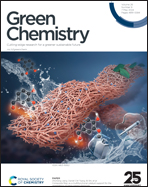Conductive V2O3 electrocatalyst on carbon hollow spheres to accelerate polysulfide conversion for long-cycle and high-rate lithium sulfur batteries†
Abstract
The intrinsic very poor electrical conductivity of many transition-metal-oxides is a bottleneck when using them as electrocatalysts in lithium–sulfur (Li–S) batteries. Herein, we report a study using metallic conductive V2O3, which is dispersed on carbon hollow spheres, as the electrocatalyst to improve the kinetics of LiPS conversion. Our experimental measurements and theoretical calculations revealed that conductive V2O3 exhibits strong interactions with LiPSs, enhancing their adsorption and conversion, while carbon hollow spheres can compensate for the poor conductivity of sulfur and inhibit sulfur's volume expansion. With a sulfur loading of 75%, the V2O3/C-HS@S cathode exhibits a high initial discharge specific capacity of 1153 mA h g−1 at 0.05C, remaining at 433 mA h g−1 after 300 cycles at 0.2C, with a capacity retention rate of 99.67%. Even at 2C after 300 cycles, the battery still retains a specific capacity of 298 mA h g−1. This work demonstrates the potential of using a conductive V2O3 electrocatalyst dispersed on carbon hollow spheres as a sulfur host in improving the long-cycle life and high-rate performance of Li–S batteries.



 Please wait while we load your content...
Please wait while we load your content...